A neonatal case from the land of shadows
A 9-day-old, 34-week premature male, who had good prenatal care and cesarean section delivery caused by severe preeclampsia, developed fever and irritability and had a sepsis workup that showed a complete blood count with 23,700 white blood cells/mm3 with 69% granulocytes; cerebrospinal fluid with more than 9,000 white blood cells and 180,000 red blood cells; glucose of zero with an increased protein; and negative Gram’s stain. Serum chemistries revealed an anion gap of 18 mmol/L.
 James H. Brien |
The baby had an MRI done revealing subgaleal, subdural and subarachnoid blood with multiple, scattered deep white matter infarcts (Figures 1-4). Empiric treatment was started with ampicillin, gentamicin and acyclovir, pending cerebrospinal fluid (CSF) cultures and herpes polymerase chain reaction (PCR) and blood cultures, which all turned out to be negative. Other pertinent negatives obtained during the next week included a respiratory virus panel (PCRs for influenza, parainfluenza, adenovirus, enterovirus and respiratory syncytial virus) and CSF enterovirus PCR, cytomegalovirus urine screen and Toxoplasma serologies. The empiric antibiotics were continued, despite the lack of an organism being identified because of the baby’s overall condition. Because of technical difficulties, the lumbar puncture was not repeated until the baby began having seizure-like activity about 10 days after the onset of fever (which never re-occurred but developed temperature control problems). At that time, the CSF revealed a white blood cell count of 2,015 and zero red blood cells, a protein of 590 mg/dL and glucose of zero. CSF cultures were again sent for routine stains and cultures plus herpes simplex virus PCR, acid-fast bacterial and fungal stains and cultures, as well as culture in urea-containing broth and special Mycoplasma hominis media. A repeat MRI is shown in Figures 5 and 6.
 Figure 1. The baby had an MRI done revealing subgaleal, subdural and subarachnoid blood with multiple, scattered deep white matter infarcts (Figures 1-4) Images: Brien JH
|
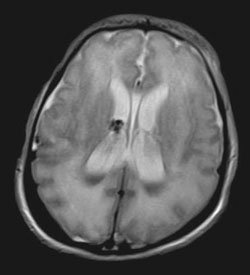 Figure 2. |
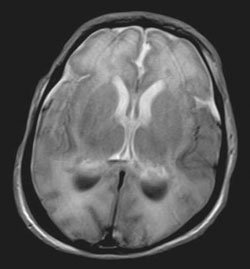 Figure 3. |
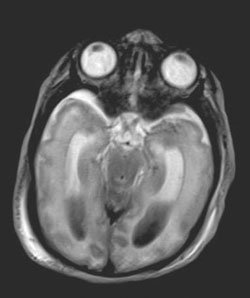 Figure 4. |
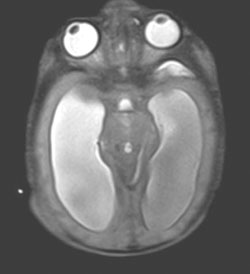 Figure 5. A repeat MRI is shown in Figures 5 and 6. |
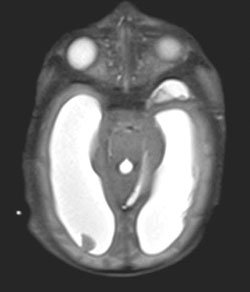 Figure 6. |
What’s Your Diagnosis?
A.Herpes meningoencephalitis
B.Group B streptococcus meningitis
C.Ureaplasma urealyticum meningitis
D.Listeria monocytogenes meningitis
The hydrocephalus and other damage to the baby’s brain shown in the MRI figures could be caused by any of the choices. There was no way to know the cause of this baby’s meningitis with certainty until the Ureaplasma culture came back positive for (C) Ureaplasma urealyticum. However, using good test-taking skills, there are some hints that should lead one to suspect something a bit unusual. Certainly, there’s nothing too unusual about a premature newborn with herpes or group B strep, plus the baby was on appropriate empiric therapy for neonatal sepsis with meningitis with the use of ampicillin, gentamicin and acyclovir, which should have been helpful against these possibilities. Despite this, his CSF continued to remain abnormal with marked pleocytosis and severe hypoglycorrhachia. All the routine cultures remained negative and the herpes PCR was negative again on the second CSF sample. As soon as the Ureaplasma culture result was known, he was started on a 21-day course of IV azithromycin plus doxycycline. About a week into the treatment, another CSF sample was obtained revealing significant improvement in its parameters and was culture-negative for Ureaplasma. The baby received a ventriculoperitoneal shunt soon after the second MRI (Figure 7) and was discharged at 2 months of age, significantly improved and continuing to do well.
 Figure 7. The baby received a ventriculoperitoneal shunt soon after the second MRI above. |
When I was a fellow in 1982, Jim Bass (my fellowship director) taught us about U. urealyticum and M. hominis and their capability for causing a variety of infectious problems in newborns (especially U. urealyticum and especially in premature neonates), from pneumonia to sepsis and meningitis to stillbirths. However, this is only the second case I can recall seeing since then. I suspect there have been others that went unrecognized because I either did not think about it or our cultures missed it. As noted in the question section, these organisms require special culture media, but can be recovered within a few days if properly handled. As pointed out in the Red Book, sometimes it’s hard to tell what is caused by the Ureaplasma and what is part of the baby’s underlying problems related to prematurity. However, in a case like this, with the positive CSF culture and the temporal improvement with appropriate anti-Ureaplasma therapy, it would seem to leave little doubt as to the role of Ureaplasma in the baby’s meningitis. These organisms lack cell walls, therefore, penicillins and cephalosporins will not work. Macrolides work by binding to the 50S subunit of the ribosome, inhibiting protein synthesis, resulting in a bacteriostatic effect.
Tetracyclines also inhibit protein synthesis by binding to the 30S subunit. Ureaplasma is a prokaryote, having both subunits. Therefore, either should be effective if able to reach the organism; however, there are no clear guidelines, only advice from recognized experts and case reports. The treatment given to this baby was based on similar reports. Since this case occurred, an excellent review was published in The Pediatric Infectious Diseases Journal by Clifford and colleagues of Australia. If you are faced with a similar case, I would review this paper before making any therapy decisions.
I know that a rare case with nothing but images to show is probably not of much interest to those of you not involved in the care of premature neonates, but we should all be aware of this possibility and understand the potential devastating consequences of a central nervous system infection caused by one of these peculiar organisms in these fragile neonates. Even if you don’t see newborns at all, you may be taking care of one of these babies when they seek a primary provider, and the above paper will give you good information on that baby’s infectious disease background. Also, the parents may come, already well-read on this subject.
References:
Clifford V. Pediatr Infect Dis J. 2010;29:60-64.
James H. Brien, DO, is a member of the Infectious Diseases in Children Editorial Board as well as Vice Chair for Education at The Children’s Hospital at Scott and White and is the Associate Professor of Pediatrics at Texas A&M University, College of Medicine, Temple, Texas. email: jhbrien@aol.com. Disclosure: Dr. Brien reports no relevant financial disclosures.
